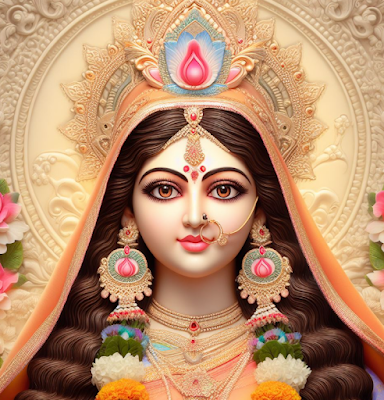Shailaputri is the first form of the Hindu goddess Durga, who is worshipped on the first day of Navratri. Her name means “the daughter of the mountain”, as she was born to the king of the Himalayas, Himavan. She is also known as Sati, Parvati, or Hemavati, and is the consort of Lord Shiva.
According to Hindu mythology, Shailaputri was the reincarnation of Sati, the first wife of Shiva. Sati was the daughter of Daksha, a powerful king and a devotee of Vishnu. Daksha did not approve of Sati’s marriage to Shiva, who was an ascetic and lived in the cremation grounds. He considered Shiva to be unworthy of his daughter and insulted him on several occasions.
Once, Daksha organized a grand sacrifice and invited all the gods and sages, except Shiva. Sati felt humiliated by her father’s act and decided to attend the sacrifice without Shiva’s permission. She hoped to persuade her father to respect her husband and mend their relationship.
However, when Sati reached the sacrificial site, she was greeted with contempt and hostility by Daksha and his guests. Daksha openly ridiculed Shiva and his followers, and refused to offer him a share of the sacrifice. Sati was enraged by her father’s disrespect and immolated herself in the sacrificial fire, as a protest against his tyranny.
Shiva was devastated by Sati’s death and carried her burnt body across the universe, unleashing his wrath on everything that came in his way. The gods were terrified by Shiva’s fury and appealed to Vishnu for help. Vishnu used his discus to cut Sati’s body into 51 pieces, which fell on different places on earth. These places came to be known as Shakti Peethas, or seats of power, where the goddess is worshipped in various forms.
Shailaputri was born as the daughter of Himavan and Menavati in her next life. She was endowed with beauty, grace, and devotion. She remembered her previous life as Sati and wished to reunite with Shiva. She performed severe penance in the forest for thousands of years, enduring heat, cold, rain, and hunger. She subsisted on fruits and leaves, and later on air alone. She renounced all worldly comforts and pleasures, and dedicated herself to Shiva.
Shiva was impressed by Shailaputri’s devotion and austerity, and agreed to marry her again. He restored her memory of their past lives and blessed her with his love. They had two sons, Ganesha and Kartikeya, who became the leaders of the gods.
Shailaputri is depicted as a fair-skinned woman with two hands. She holds a trident in her right hand and a lotus flower in her left. She rides on a bull named Nandi, who is also Shiva’s mount. She wears a crescent moon on her forehead, which symbolizes her connection with Shiva. She is dressed in a pink or red saree, which represents love and compassion.
Shailaputri is the goddess of the root chakra, or Muladhara, which is located at the base of the spine. The root chakra governs the basic needs of survival, security, and stability. It also connects one with the earth element and nature. By worshipping Shailaputri, one can awaken the root chakra and attain physical and mental balance.
Shailaputri is also associated with the moon, which influences the tides, emotions, and cycles of life. She controls the lunar phases and regulates the menstrual cycle in women. She bestows fertility, prosperity, and happiness on her devotees.
The mantra for worshipping Shailaputri is:
ॐ देवी शैलपुत्र्यै नमः॥
Om Devi Shailaputryai Namah॥
The meaning of this mantra is:
I bow to the goddess Shailaputri, who is the daughter of the mountain.
- The puja vidhi for worshipping Shailaputri is:On the first day of Navratri, take a bath in the morning and wear clean clothes.
- Place an idol or a picture of Shailaputri on a pedestal or a platform.
- Offer red or pink flowers, incense sticks, lamps, fruits, sweets, coconut, rice grains, vermilion, turmeric powder, water, milk, honey, curd, ghee, sugar cane juice etc.
- Recite the mantra 108 times while offering water or milk to the idol or picture.
- Perform the aarti with a lamp and sing the praises of the goddess.
- Distribute the prasad among the family members and the needy.
The aarti for worshipping Shailaputri is:
जय शैलपुत्री माता, जय शैलपुत्री माता।
शिव शंकर की प्रिया, शिव शंकर की प्रिया॥
Jai Shailaputri Mata, Jai Shailaputri Mata।
Shiv Shankar Ki Priya, Shiv Shankar Ki Priya॥
The meaning of this aarti is:
Glory to the mother Shailaputri, glory to the mother Shailaputri।
She is the beloved of Lord Shiva, she is the beloved of Lord Shiva॥
Shailaputri is the first and foremost aspect of Durga, who represents the pure and primal energy of the universe. She is the source of all creation and sustenance. She is the mother of all beings and the consort of the supreme lord. She is the embodiment of simplicity, humility, and devotion. By worshipping her, one can attain peace, harmony, and fulfillment in life.


 Instagram
Instagram
Subscribe , Follow on